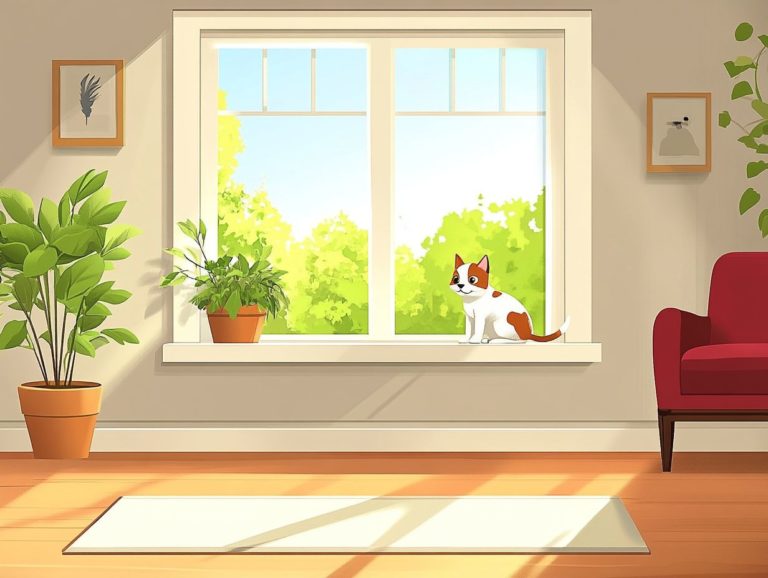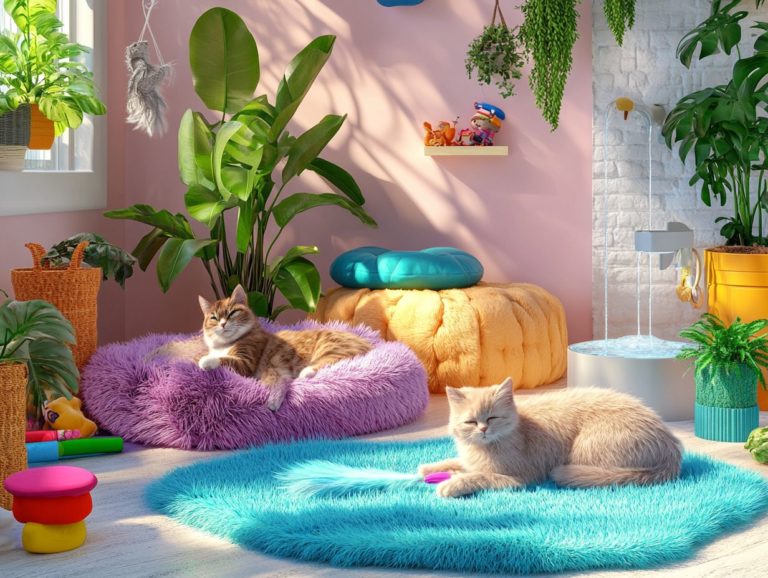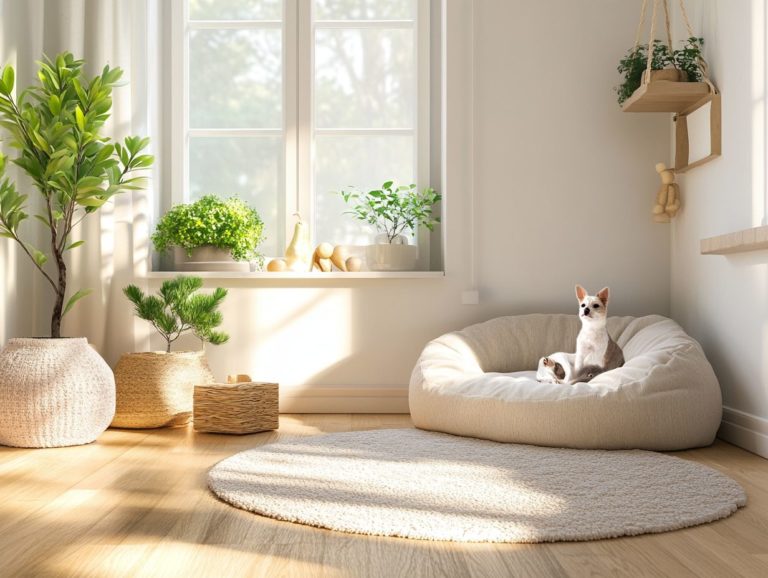How to Use Visual Barriers to Calm Pets
Creating a peaceful environment for your furry companions is crucial for their well-being, particularly in stressful situations. This article delves into the significance of calming pets through visual barriers, a straightforward method for reducing anxiety. You’ll explore the various types of barriers available, how to choose the best one tailored to your pet’s specific triggers, and techniques for training your pet to respond positively. Keep reading to learn how you can create a cozy haven for your furry friend!
Contents
- Key Takeaways:
- The Importance of Calming Pets
- Types of Visual Barriers
- How to Choose the Right Visual Barrier
- Training Your Pet to Respond to Visual Barriers
- Additional Tips for Calming Pets
- Seeking Professional Help if Needed
- Frequently Asked Questions
- Calm Your Pet with Visual Barriers: Here s How!
- Are Visual Barriers Effective for All Types of Pets?
- How Can I Determine Where to Place Visual Barriers in My Home?
- What Materials Can I Use to Create Visual Barriers?
- How Should I Introduce My Pet to Visual Barriers?
- Can Visual Barriers Be a Long-Term Solution?
Key Takeaways:

- Understand the importance of using visual barriers to calm pets.
- Consider your pet’s triggers when choosing a visual barrier.
- Train your pet to respond positively with consistency.
The Importance of Calming Pets
Calming pets transcends mere comfort; it s crucial for their overall well-being, particularly in potentially stressful situations like veterinary visits. By grasping the significance of managing fear and anxiety in dogs, you can profoundly influence their behavior. This proactive approach not only prevents issues such as reactivity and aggression but also fosters more harmonious interactions between you and your canine companion.
Understanding the Need for Visual Barriers
Visual barriers are vital for managing dog reactivity and alleviating anxiety during stressful situations. By limiting what your dog can see, these barriers help reduce excessive barking and barrier aggression. This cultivates a calming environment for both you and your pet.
In fact, these barriers can be critical in various settings, whether you’re navigating a bustling dog park or encountering unfamiliar animals. By reducing environmental stressors through visual obstruction, fearful dogs can feel more secure, which in turn diminishes their instinctive reactions to perceived threats. This newfound sense of safety fosters better socialization and smoother interactions, ultimately shaping overall canine behavior.
With a thoughtfully designed setup, you can create a sanctuary that caters to your dog s emotional needs while ensuring a more enjoyable experience for everyone involved.
Types of Visual Barriers
Visual barriers fall into two primary categories: physical barriers and visual distractions. Each type serves a distinct purpose in fostering a calm and safe environment for your pets.
Physical barriers, crafted from opaque materials, effectively obstruct a dog’s view of potentially stressful stimuli, providing a sense of security. On the other hand, visual distractions gently redirect your pet’s attention away from these stimuli, contributing to a more tranquil atmosphere.
Physical Barriers
Physical barriers, such as dog fences and cardboard constructions, serve as effective solutions for creating a calming space for your pets. Typically crafted from opaque materials, these barriers effectively block visual stimuli, significantly reducing the likelihood of anxiety and aggressive reactions in dogs.
You can choose from solid wood, vinyl, or even chain-link options. This allows you to select materials that best fit your environment and cater to your dog’s specific needs. For instance, a sturdy wooden fence not only offers durability but also enhances the aesthetic appeal of your property, while vinyl provides a low-maintenance alternative that remains visually pleasing. If you’re on a budget, cardboard panels present a temporary solution, offering a lightweight and easily movable option.
Each type of barrier offers unique benefits, such as creating a secure zone that minimizes distractions during stressful situations like loud noises or busy gatherings. This thoughtful approach ultimately contributes to improving your dog’s emotional well-being.
Start today by assessing your pet’s environment your furry friend deserves a calm and happy space!
Visual Distractions

Transform your pet’s anxiety into calmness! Visual distractions can be a powerful tool for managing your pet’s anxiety and reactivity, effectively shifting their focus away from stress-inducing stimuli. By using favorite treats or engaging toys, you can create positive associations that aid in stress relief and behavior modification.
Introducing visually stimulating objects, like brightly colored puzzles or interactive games, allows you to capture your pet’s attention during particularly triggering moments. Incorporating a favorite squeaky toy or a vibrant bouncing ball can help redirect their focus from overwhelming sights or sounds, fostering a sense of calm.
Creating a soothing backdrop, perhaps with a tranquil video of nature scenes, can establish a comforting atmosphere that alleviates stress. It s essential to experiment with different techniques to discover the right combination that not only diverts attention but also reinforces your pet s sense of safety and tranquility in their environment.
How to Choose the Right Visual Barrier
Choosing the right visual barrier requires understanding your pet’s specific triggers and tailoring the barrier to the situation at hand, ultimately enhancing effective anxiety management.
Consider factors such as your pet’s level of reactivity and the context in which the barrier will be employed. This is crucial in selecting the most suitable solution for calming your pet.
Considering Your Pet’s Triggers
Understanding your pet’s unique triggers is crucial when selecting an effective visual barrier to manage stress and prevent aggressive responses. By identifying specific environmental stressors that provoke anxiety, you can make informed decisions about the type of barrier that will provide optimal comfort.
Common triggers might include:
- Loud noises
- Unfamiliar animals
- Sudden movements
Pay attention to how your pet reacts in various situations. For instance, does your pet bark excessively when people pass by the window, or do they retreat and hide when certain sounds arise?
Being observant helps evaluate the need for physical barriers, such as privacy screens or outdoor shades, to minimize exposure to unsettling stimuli. Grasping this connection can significantly enhance your pet’s sense of security, leading to a calmer and more relaxed demeanor.
Matching the Barrier to the Situation
When selecting a visual barrier, it’s essential to match the type of barrier to the specific situation. This ensures low-stress handling and prioritizes pet comfort during veterinary visits. Consider factors such as the pet’s behavior and the environment to effectively reduce anxiety and create a calming atmosphere.
A transparent acrylic barrier might be ideal in a bustling clinic, allowing the veterinary staff to observe the pet while providing a sense of security. On the other hand, in a quiet setting, a solid, softer barrier can help create an enclosed and comforting space for a nervous pet.
Don t forget to consider the size and age of the pet; younger or more energetic pets may benefit from barriers that offer both visual privacy and an adequate level of stimulation. Tailoring these choices to the individual animal’s needs significantly enhances their experience and promotes a more positive outcome during their visit.
Training Your Pet to Respond to Visual Barriers
Training your pet to respond positively to visual barriers is an essential step in managing their anxiety and instilling a sense of security. By employing positive reinforcement techniques, such as changing how your pet feels about the barrier, you can cultivate favorable associations with the barrier.
This method gradually gives your pet the power to handle stress more effectively, all while building their confidence along the way.
Try these tips today and watch your furry friend thrive!
Positive Reinforcement Techniques

Positive reinforcement techniques are essential for training your pets to accept visual barriers. They encourage desired behaviors through rewarding experiences. By using high-value treats and creating positive associations during their exposure to the barrier, you can significantly enhance the training journey for fearful or anxious animals.
These methods do more than just promote a sense of security. They also build trust between you and your pet. For example, when introducing your dog to a gate for the first time, rewarding it with treats each time it calmly approaches can be incredibly effective. Similarly, if you have a cat that s hesitant about a new litter box behind a screen, offering its favorite toy or treats when it ventures nearby can spark curiosity and acceptance.
Over time, these positive experiences will help your pets not just adapt but truly thrive. This showcases the powerful impact of reinforcement in a nurturing training environment.
Consistency and Patience
Consistency and patience are the cornerstones of your training strategy when helping your pets adapt to visual barriers. By adopting a steady approach, you can effectively change behaviors and nurture a more trusting relationship with your furry companions. This ultimately leads to better responses in stressful situations.
Establishing a regular schedule for training sessions will reinforce those desired behaviors. This allows your dog to learn in a comfortable and familiar rhythm. Integrating short, focused exercises into your daily routine can significantly enhance retention, enabling your pet to grasp concepts more efficiently over time.
Don t underestimate the power of celebrating small victories with positive reinforcement! This not only motivates your dog but also strengthens the bond you share. Remember, every pet learns at their own pace, and recognizing this will help you remain patient. It s crucial to create a supportive environment where anxiety lessens and confidence flourishes.
Additional Tips for Calming Pets
In addition to employing visual barriers, you can explore several strategies that will further assist in calming your pets and managing their anxiety.
By combining various techniques, such as making thoughtful environmental modifications and seeking professional assistance, you pave the way for more effective stress reduction and enhanced animal welfare. Try adding a cozy blanket or a favorite bed to create a safe space!
Combining Visual Barriers with Other Techniques
Are you struggling to help your pet feel at ease? Combining visual barriers with other calming techniques can significantly elevate your stress relief efforts. This offers a more holistic approach to managing your dog’s reactivity, particularly in addressing issues such as territorial aggression.
By implementing distraction techniques alongside barriers, you create a multi-faceted strategy that addresses the various behavioral signs of anxiety in your pet. For instance, when your dog encounters stimuli that trigger stress, using a privacy screen can effectively block their view of distractions, like passing cars or other animals.
Pairing this with soothing sounds or aromatherapy think lavender essential oils can further help alleviate anxiety levels. Engaging in gentle training sessions using positive reinforcement while the visual barrier is in place can also redirect your dog’s focus, fostering a sense of calm.
Scenarios where such integrative methods are successfully applied often reveal a noticeable decrease in barking and other signs of distress. This highlights the effectiveness of a comprehensive approach to emotional well-being. Start today for a happier, calmer pet!
Seeking Professional Help if Needed
If your pet’s anxiety or reactivity lingers even after you ve put visual barriers and other techniques into play, don t wait get your pet the professional help they deserve. Veterinary teams can craft custom plans that fit your pet’s needs and offer insights into behavioral signs, ensuring your pet gets the right care and support they need.
Grasping the intricate nuances of animal behavior is essential for effective management. Professionals bring specialized expertise that allows for a thorough assessment of the situation, considering factors like the environment, social interactions, and medical history. They collaborate with you to pinpoint triggers and develop practical strategies that merge behavioral modifications with possible medical interventions.
This expert guidance is essential for easing the distress in anxious pets and creating a more harmonious home environment. Ultimately, it enhances the quality of life for both your furry friend and your family.
Frequently Asked Questions

Calm Your Pet with Visual Barriers: Here s How!
Visual barriers are physical objects or barriers that block the direct line of sight between pets and potential stressors. They can include things like curtains, screens, or furniture. By using visual barriers to block the view of potential stressors, pets can feel more secure and calmer.
Are Visual Barriers Effective for All Types of Pets?
Yes, visual barriers can be effective for calming all types of pets. They are especially helpful for pets who are easily stimulated by outside stimuli, such as loud noises or other animals. Additionally, considering soundproofing tips for anxious pets can further enhance their comfort.
How Can I Determine Where to Place Visual Barriers in My Home?
Observe your pet’s behavior and reactions to different areas of your home. If you notice they become anxious or agitated in certain areas, those may need visual barriers. Consider potential stressors outside, such as busy streets or neighboring animals.
What Materials Can I Use to Create Visual Barriers?
There are various materials that can create effective visual barriers for pets. Options include curtains, room dividers, baby gates, or even large plants. Choose a material that blocks the view but also fits with your home’s decor.
How Should I Introduce My Pet to Visual Barriers?
Introduce your pet to visual barriers slowly and positively. Start by placing the barrier in a familiar area and allow your pet to explore it at their own pace. Use treats or toys to create a positive association. Gradually move the barrier to new areas as your pet becomes more comfortable.
Can Visual Barriers Be a Long-Term Solution?
Yes, visual barriers can be a long-term solution for calming pets. However, it s important to address the root cause of the pet’s anxiety or stress. Consult with a veterinarian or animal behaviorist for additional strategies to help your pet feel calmer and more secure.
For more information, reach out to a professional to ensure your pet receives the best care possible.






